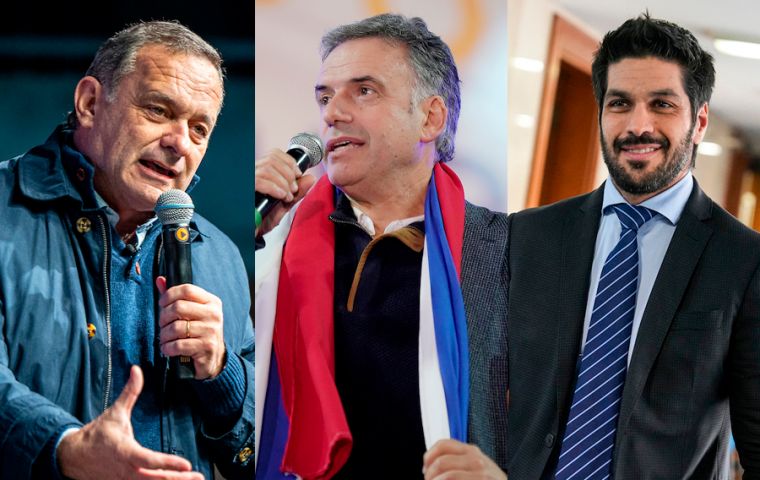MercoPress. South Atlantic News Agency
Uruguay’s internal elections: Key players and possible outcomes
 Delgado, Orsi and Ojeda lead the polls in Uruguay's three main parties.
Delgado, Orsi and Ojeda lead the polls in Uruguay's three main parties. As the internal elections for Uruguay’s major political parties approach next Sunday, the consulting firm Opción Consultores has released a public opinion report evaluating the potential impact of voter turnout on the outcomes for the Frente Amplio (FA), Partido Nacional (PN), and Partido Colorado (PC). The report, released this Thursday, provides a detailed analysis of how varying levels of voter participation could influence the percentage of votes each pre-candidate might receive.
Frente Amplio (FA): Orsi Leads Over Cosse
In the leftist opposition Frente Amplio, which is favored in these elections, the report from Opción suggests that Yamandú Orsi holds a slight advantage over Carolina Cosse. With an estimated 10% turnout of eligible voters, Orsi leads with 52%, followed by Cosse with 46%, and Andrés Lima with 1%. The remaining 1% are undecided or did not respond.
In a higher turnout scenario, with 14% of eligible voters participating, Orsi’s lead increases to 56%, while Cosse’s support drops to 43%. The undecided/no response category remains below 1% in both scenarios.
Partido Nacional (PN): Delgado's Dominance
For the Partido Nacional, Opción outlines two scenarios based on voter turnout. With a lower turnout of 13%, Álvaro Delgado is the clear frontrunner with 68% of the vote, followed by Laura Raffo at 19%, and Jorge Gandini at 4%. The undecided/no response category is 9%.
In a scenario with higher participation, 16% of eligible voters, Delgado’s support decreases to 61%, Raffo’s increases to 21%, and Gandini’s slightly decreases to 3%. Notably, the undecided/no response category rises to 14%.
Partido Colorado (PC): Ojeda Leads
The Partido Colorado’s internal election scenario, with an estimated 4% turnout, places Andrés Ojeda in the lead with 41%. He is followed by Robert Silva at 22%, Gabriel Gurméndez at 17%, Tabaré Viera at 13%, and Carolina Ache Batlle at 2%. The undecided/no response category stands at 5%.
Methodology and Insights
The survey, conducted by telephone between June 17 and 26, sampled 1,722 cases. Opción emphasizes that the central estimates are based on the subsample of likely voters in the internal elections of FA, PN, and PC. The firm used different turnout scenarios to create a Voting Turnout Index (VCI) to better predict which segments of the electorate are most likely to participate.
Opción highlighted the complexity of estimating voter turnout, given that participation in internal elections is not mandatory. The firm designed the VCI to focus on probable voters, factoring in historical turnout data from previous elections.
The report, presented on Telenoche (Channel 4), underlines that “the two estimates made within the Frente Amplio based on minimum and maximum turnout levels show an advantage for Yamandú Orsi over Carolina Cosse. However, the distances are different in each case.”
Uruguay, the so-called oasis of political stability in Latin America, will elect its next president (2025-2030) in October. The people of the South American country will decide whether to continue with a second period of the center-to-center-right coalition, formed mainly by the Partido Nacional and the Partido Colorado, or to return to the leftist but also liberal path of the Frente Amplio.




Top Comments
Disclaimer & comment rulesCommenting for this story is now closed.
If you have a Facebook account, become a fan and comment on our Facebook Page!